1. Introduction
Transfer fees paid by football clubs to recruit new players have strongly increased over the past few years. With the growth in revenues of the top-flight European teams along with those of all English Premier League clubs, a new record for expenditure will most probably be set during the next transfer window.
The CIES Football Observatory is able to predict the footballers of the five major European leagues who are the most likely to be transferred for a sum of money during next summer. We are also capable of estimating the transfer value of big-5 league players taking into account the amounts previously paid for footballers with similar characteristics.
Our estimations are based on statistical models developed from a detailed analysis of deals concluded over the last six years. No subjective data is taken into account. Transfer rumours have no place in our approach. Neither do our estimates include clauses that fix the fee at which certain players can be transferred.
Since the 2013 summer transfer window, the correlation between values estimated by our algorithm and the sums actually paid for the recruitment of big-5 league players has been close to 80%. The strength of this correlation shows that, on one hand, the footballers’ transfer market is rational and, on the other, that its rationality has been well understood by the econometric model developed by the CIES Football Observatory academic team.
Moreover, the model estimating the probabilities of paying fee transfers has turned out to be very accurate. Of the twenty footballers that we identified as most likely to be transferred for a fee in June 2015, twelve actually left, five extended their contract and only three stayed in their home club without renewing their contract.
The estimated transfer values were, on average, slightly lower than the sums actually invested. This gap is explained by the inflation in transfer costs. Insofar as nothing indicates that the inflation has topped out, a supplement of 10% was applied to each footballer whose transfer value appears in this report. This percentage corresponds to the underestimated amount observed on average so far.
Our approach also takes into account the level of the team interested in acquiring the services of a player. A wealthy club such as Manchester City, for example, should pay more than West Bromwich Albion for the same player. To simplify, the values presented refer to the corresponding fee for the team most likely to recruit the player in question taking into account his characteristics and performances.
This Report first examines the criteria used to evaluate both players’ transfer values and probabilities. We then present the big-5 league footballers most likely to be the object of a paid transfer during next summer. The following chapter lists the players with the highest transfer value. In the conclusion, we reiterate the principle applications possible for the algorithms elaborated by the CIES Football Observatory research group.
2. Valuation criteria
To determine transfer values and probabilities on a scientific basis, our academic team first analysed in detail the trajectories of players having recently participated in the five major European leagues. Among these are over 2,000 footballers that have been the object of paying fee transfers since July 2010.
Using statistical modelling techniques, we have been able to identify the criteria that affect the determination of transfer fees, as well as the factors influencing the probability of a player being transferred for a sum of money. These variables refer to both players and their teams.
A first group of indicators concerns the characteristics of players such as age, position, length of contract remaining and the residual book value. The latter variable is calculated from the transfer fee amount paid by the employer club, divided according to the percentage of years of contract since the signature.
A second group of indicators takes into account the players’ performances, notably in terms of the amount of time played in the different club competitions (domestic leagues, cups) or, eventually, in national teams. Recent performances are given more weight than previous ones.
The last family of indicators refers to the level of the leagues where the footballers played their matches, as well as to the results obtained by the employer clubs. The level of the national team represented is also taken into account.
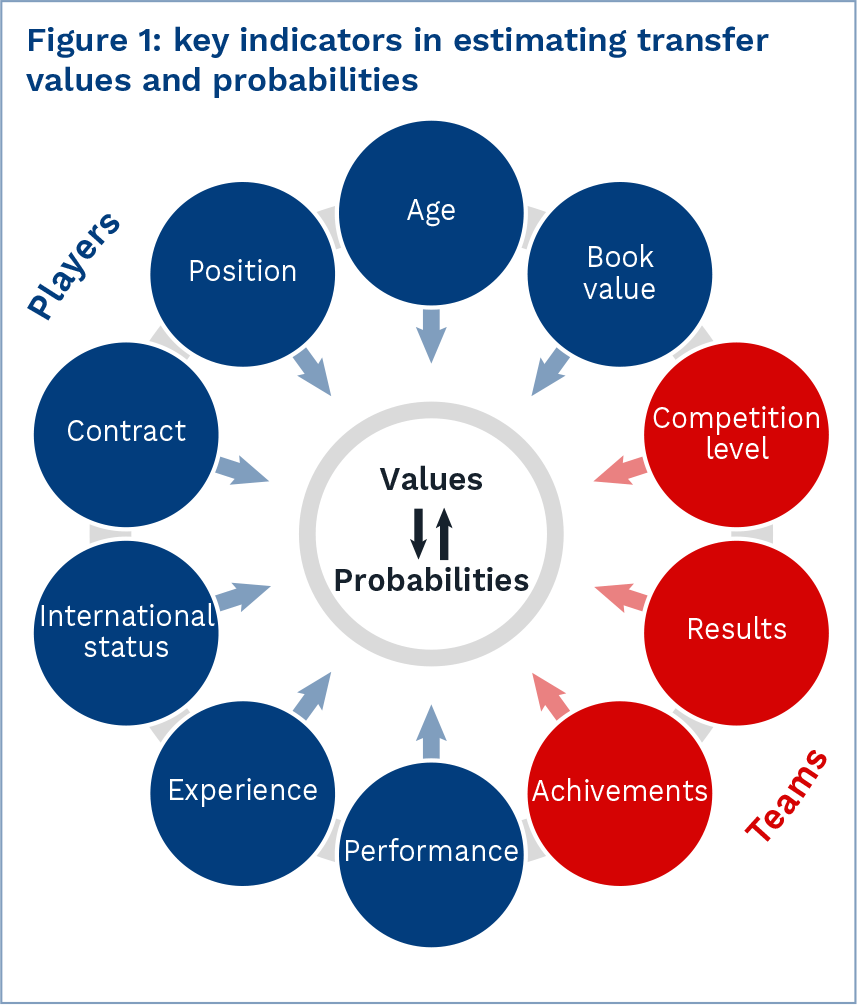
3. Probabilities of fee paying transfers
This chapter presents the rankings of footballers identified by our model as being the most likely to be transferred for a fee during the 2016 summer transfer window. Players on loan have not been included in the analysis.
Numerous footballers from relegated clubs figure among those for whom a paid departure is the most probable. Indeed, relegation obliges teams to compensate decreasing revenues by selling players. This also gives an incentive to the players themselves to leave. Consequently, relegated clubs generally offer interesting recruitment possibilities.
There are many top-flight forwards among the players whose transfer value is over €25 million and who are most likely to be transferred. Gonzalo Higuaín heads the rankings. The 28-year-old Argentinean has only two years of his contract left to run. According to our analysis, it is very probable that he will be signed by a wealthier club than Naples.
Three other players whose transfer value is over €50 million are likely to leave: Antoine Griezmann and Koke Resurrección from Atlético Madrid, as well as Everton’s Romelu Lukaku. Mauro Icardi (Inter) and Alexandre Lacazatte (Lyon) are also strong contenders for the most expensive summer transfers.
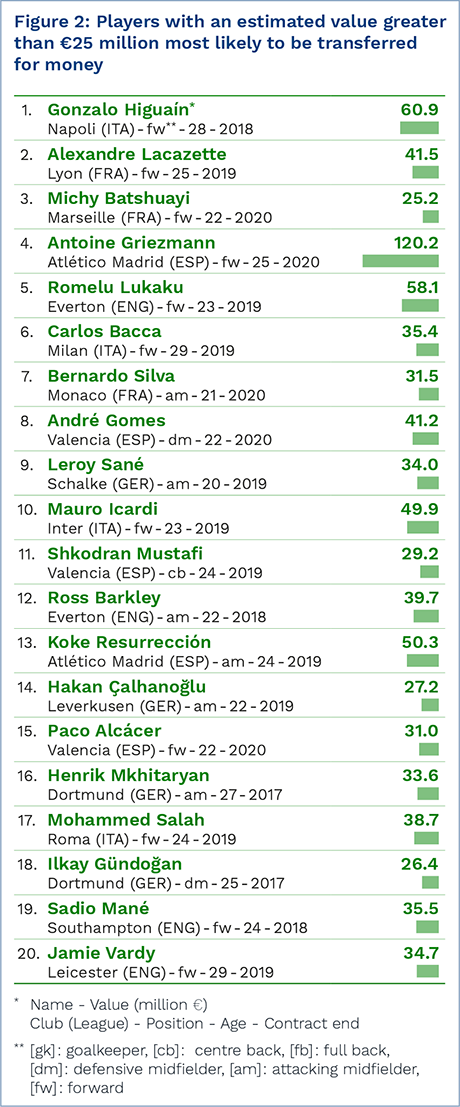
Newcastle’s surprise relegation will probably result in the departure of quality players. According to our analysis, four footballers from the club whose value is between €15 and €25 million are likely to be transferred: Georginio Wijnaldum, Aleksander Mitrović, Chancel Mbemba and Jonjo Shelvey. Mario Götze (Bayern Munich) is also likely to find a new club as his contract has only one year left to run.
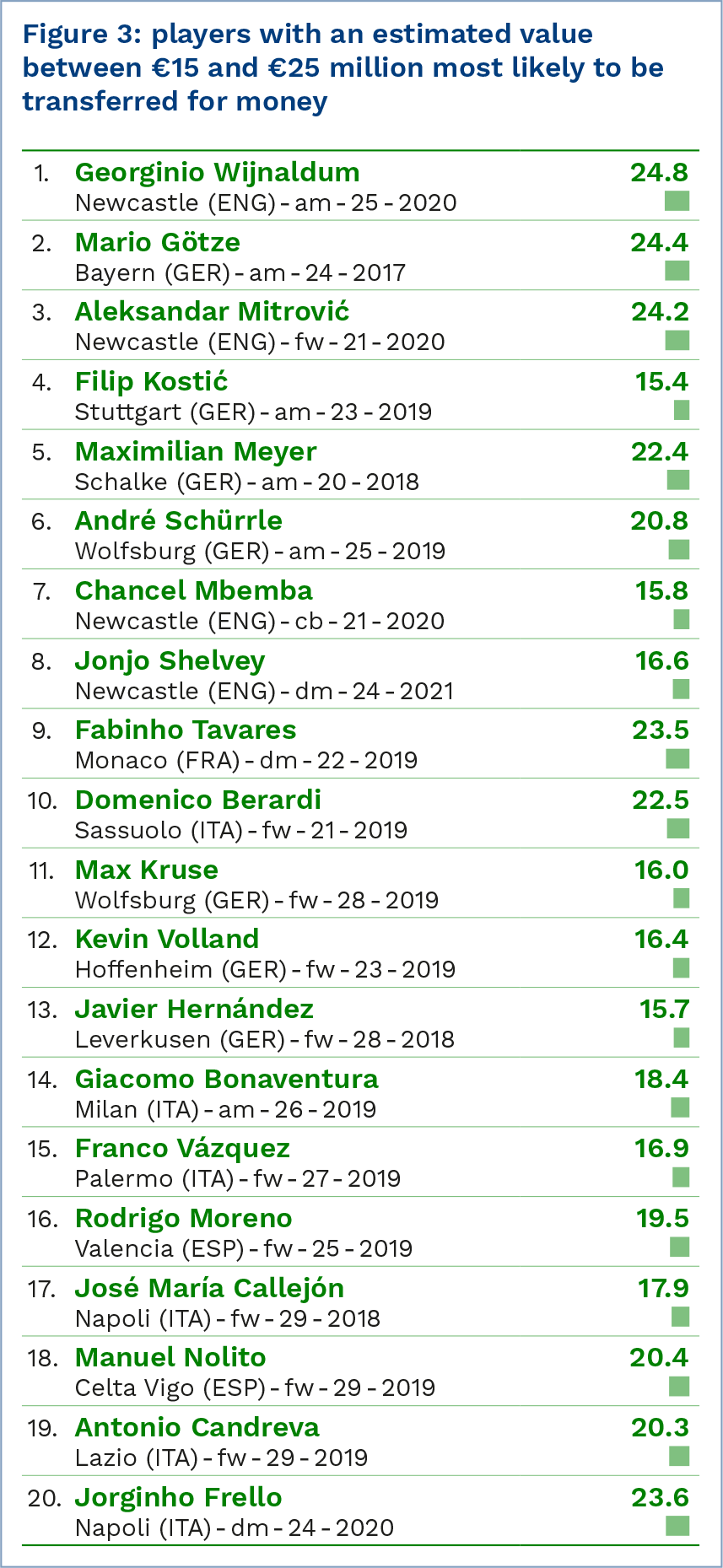
Numerous talents are among the 20 players with a transfer value between €7.5 and €15 million who are the most likely to leave their current club. The youngest of them is Stuttgart’s Timo Werner. Only Nicola Sansone (Sassuolo) is more likely to be transferred for a fee than the German striker. Three 21-year-old players are also in the top 20: Leon Goretzka (Schalke 04), Karim Rekik (Olympique Marseille) and Bruno Fernandes (Udinese).
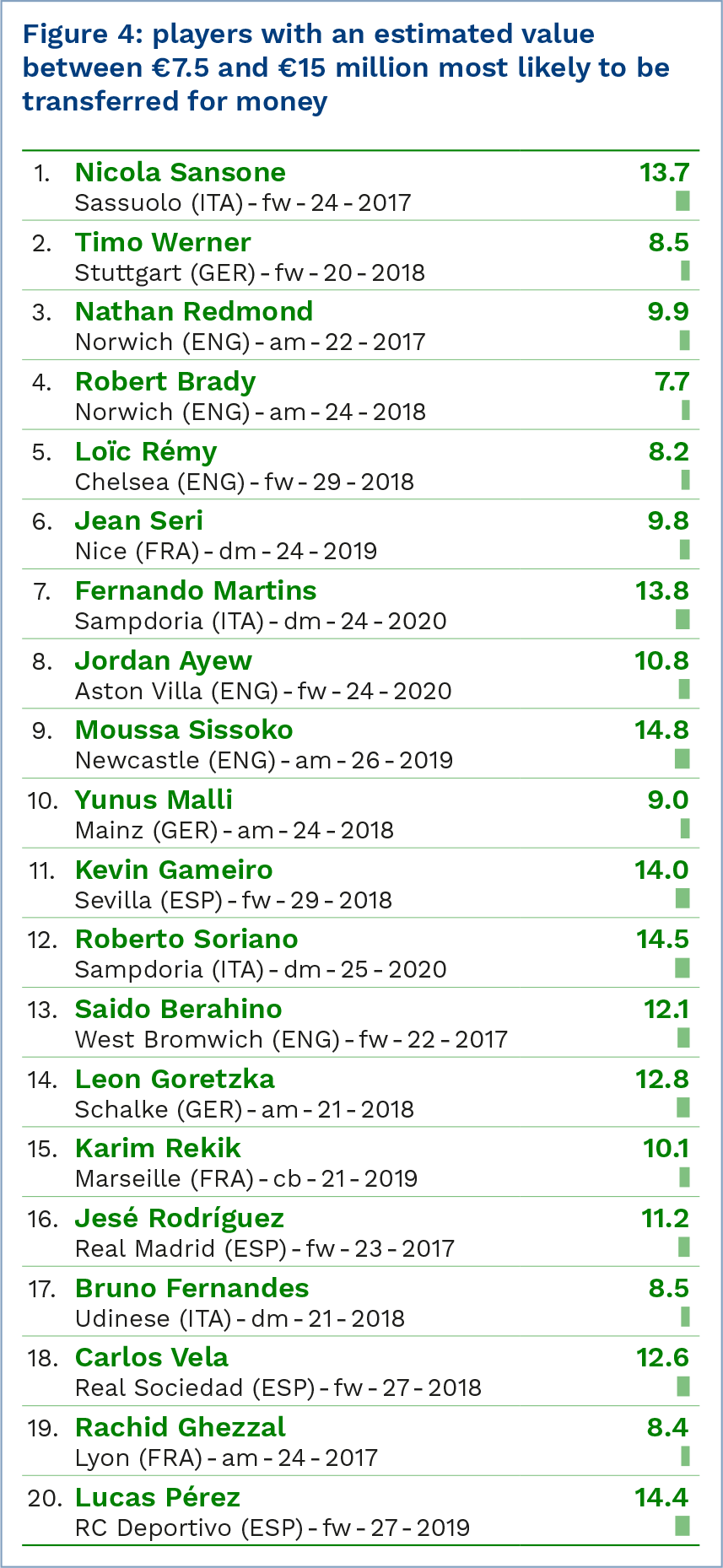
Players with only one year of contract remaining are clearly over-represented among footballers valued between €2.5 and €7.5 million most likely to be transferred for a fee. Indeed, if the player does not want to extend his contract, his club is pushed to transfer him to avoid a free departure. This case in point is notably that of Wissam Ben Yedder. The Toulouse striker is ahead of Aïssa Mandi (Stade Reims) and teammate Martin Braithwaite.
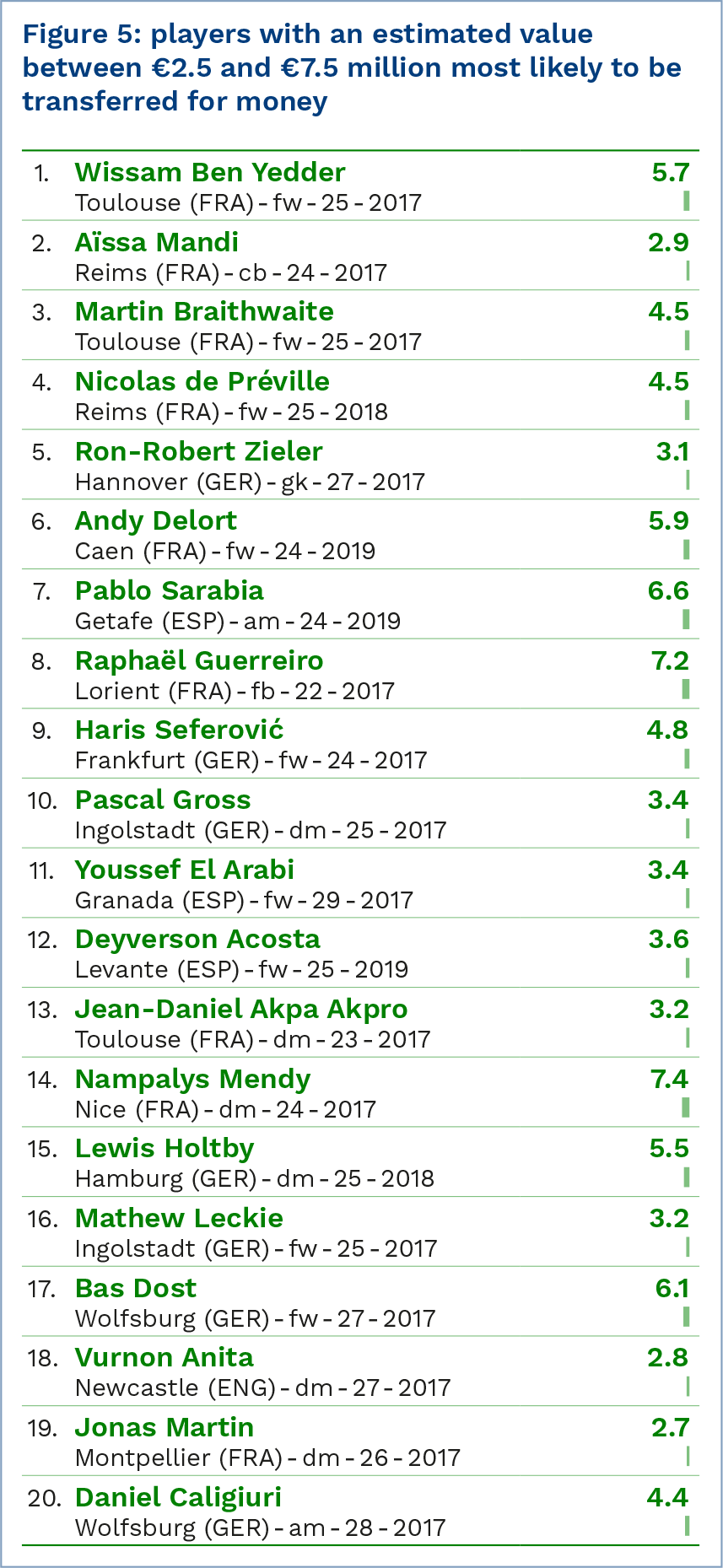
Eighteen of the 20 players most likely to be transferred for a fee among those whose transfer value is under €2.5 million have only one year of contract to run. With the exception of Lukas Hinterseer (Ingolstadt), they are all from relegated teams. Heading the list is Verona’s Artur Ioniță from Moldova. Four players from Hanover are also in the top 20 rankings: Miiko Albornoz, Salif Sané, Kenan Karaman and Lasse Sobiech.
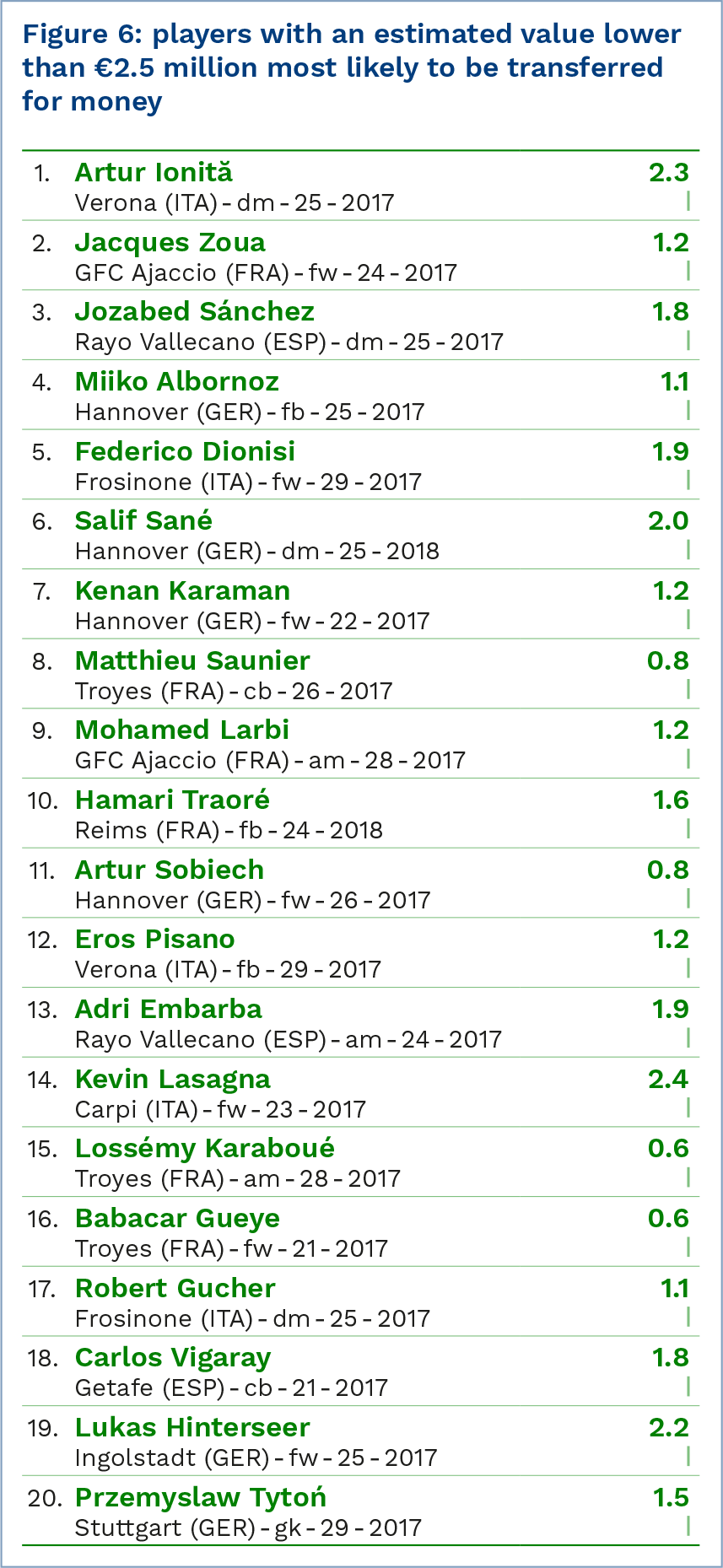
4. Transfer values
This chapter presents the rankings for big-5 league players with the highest transfer values as of 1st June 2016. Matches played or contract extensions occurred after this date have not been included in the analysis. However, the estimations take into account the inflationist trend of transfer fees.
The majority of footballers with the highest transfer value play in the top-flight teams, are active internationals, have a long-term contract and are less than 27 years of age. As of July 2015, Lionel Messi tops the rankings. However, his top spot is under increasing threat from his teammate Neymar. Given their age difference, a change in the first position seems unavoidable, especially if the Brazilian renews his contract with Barcelona.
Cristiano Ronaldo, ranked third, is the only player having celebrated his 31st birthday among the 100 most expensive players. This result is explained by the fact that clubs are prepared to pay substantial transfer fees above all when footballers have many years left in the career to play.
In total, eight players have a transfer value of over €100 million. The youngest of them, Antony Martial, is only 20 years of age. Another Frenchman, Antoine Griezmann, is the most likely to be transferred. A third Frenchman, Paul Pogba, has the highest value for central midfielders. With four players, only the Argentineans outnumber the French in the top 20 list: Lionel Messi, Paulo Dybala, Sergio Agüero and Gonzalo Higuaín.
The vast majority of footballers on the list play for competitive teams. Indeed, good results have a positive effect on the value of squad members. Conversely, poor results do not allow clubs to show players under contract in the best light. Good individual performances can only partially compensate collective weaknesses.
Most of the footballers with the highest transfer values play in attacking positions. This player profile is indeed traditionally the one for which clubs are prepared to pay the highest fees. This result would lead one to believe that offensive talents are rarer and thus more sought after. Another possible explanation is that footballers playing in attack are simply more visible and admired by spectators than their colleagues playing in a more defensive role, which could lead to clubs pushing up the bidding price to ensure their services.
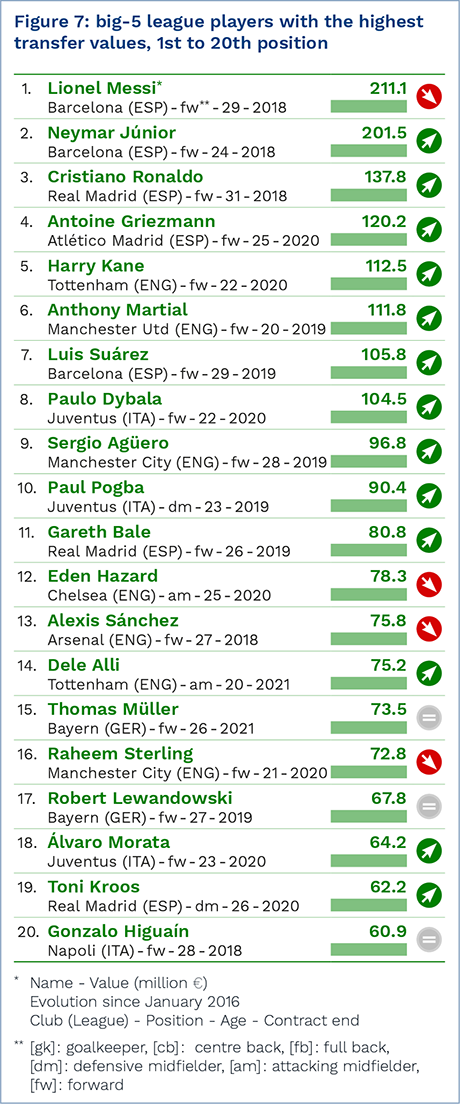
Three defenders are ranked between the 21st and 40th place for big-5 league footballers with the highest transfer values: Hector Bellerín (Arsenal), David Alaba (Bayern Munich) and Raphaël Varane (Real Madrid). Though they are still young, they already have considerable international experience. According to our analysis, Thibault Courtois (Chelsea) is the most expensive goalkeeper: €48.4 million (35th).
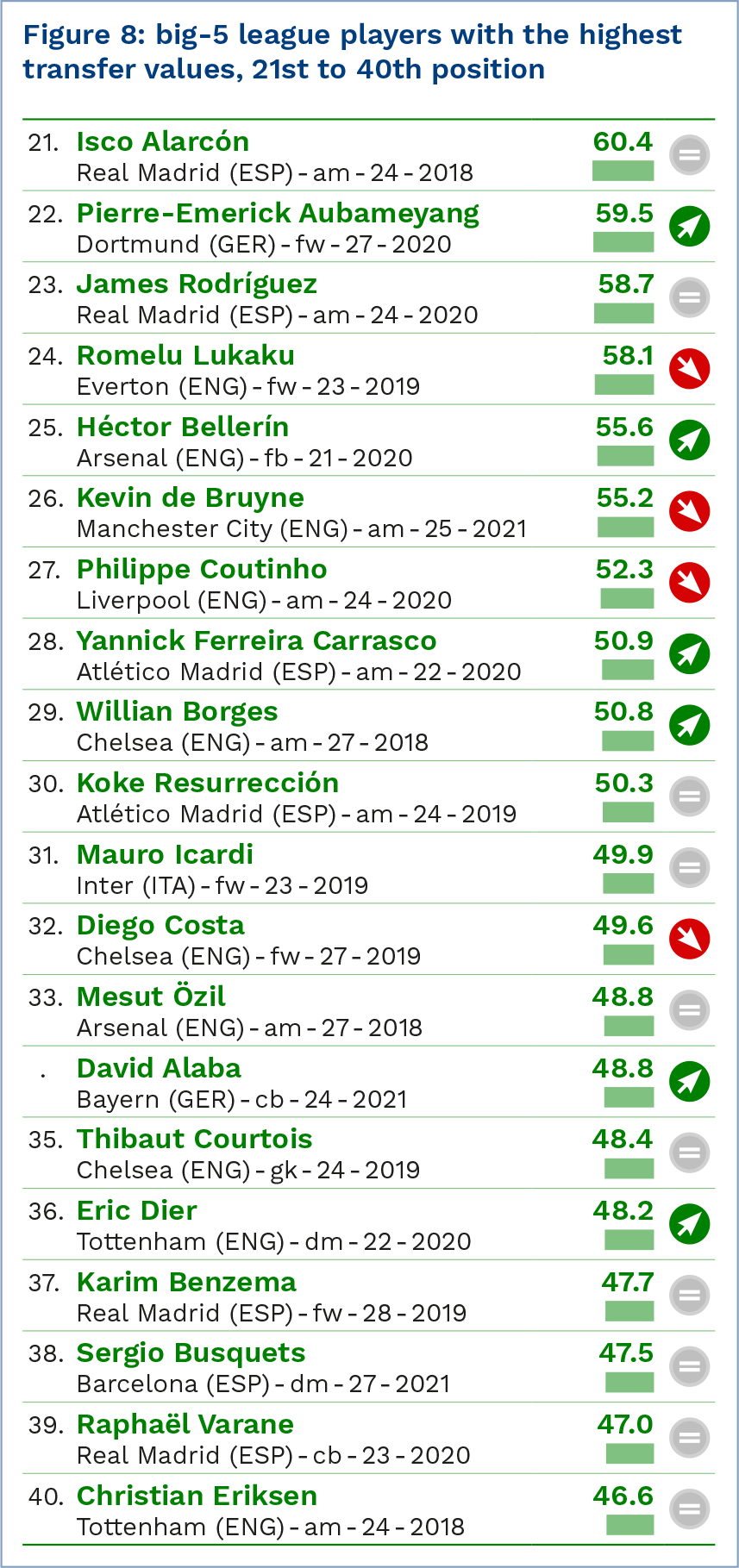
Victory in the English Premier League has allowed Leicester City to showcase their players. The most expensive among them is the French neo-international N’Golo Kanté, closely followed by the Algerian international Riyad Mahrez. According to our analysis, the transfer value of goalkeepers David de Gea (Manchester United) and Jan Oblak (Atlético Madrid) is also above 40 million €.
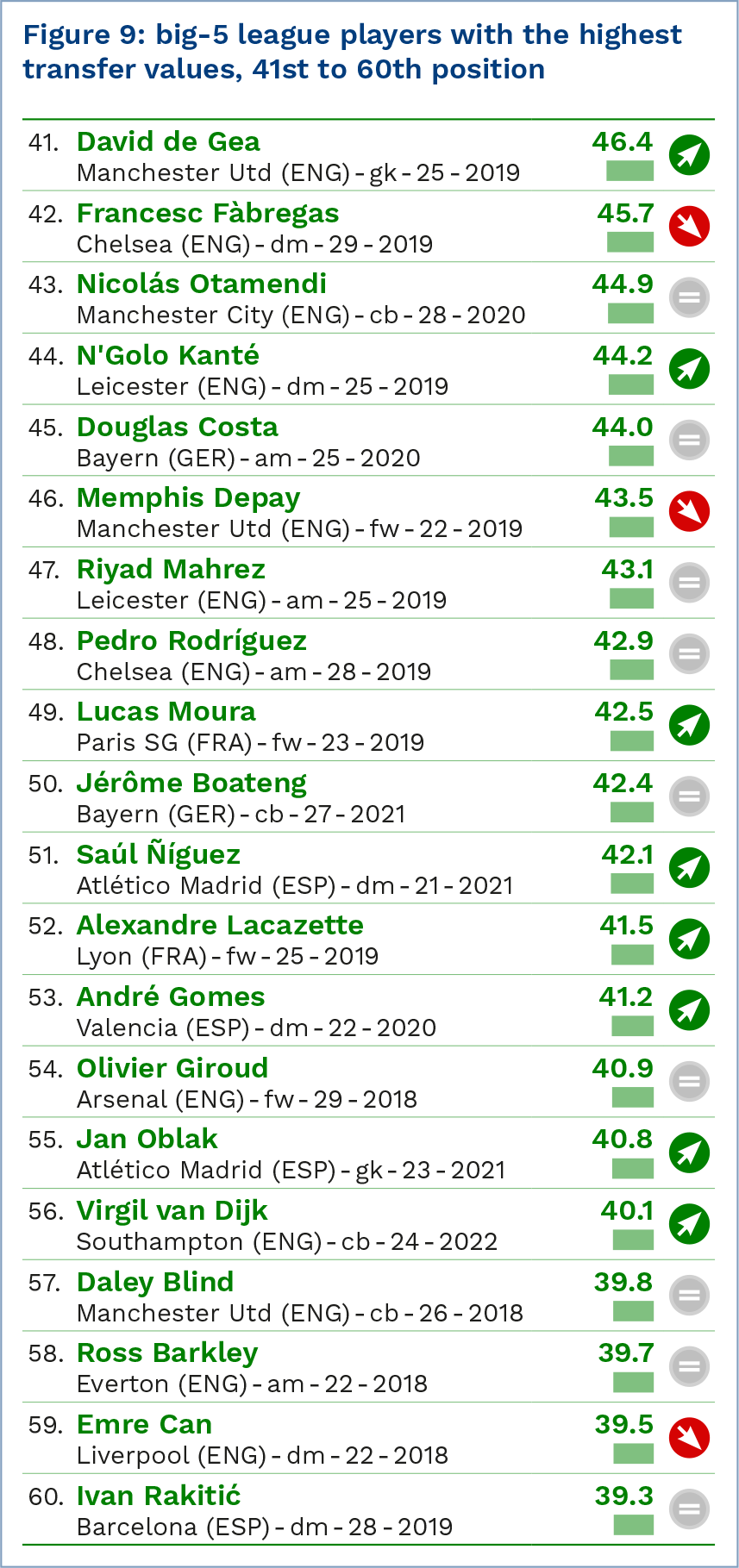
The transfer values of players ranked between 61st and 80th place are situated between €34 and €38 million. Alongside Cristiano Ronaldo, the Bayern Munich world champion Manuel Neuer (72nd) is the only player in the top 100 having already celebrated his 30th birthday. The transfer value of Marco Verratti (61st) sharply decreased compared to January due to his injury.
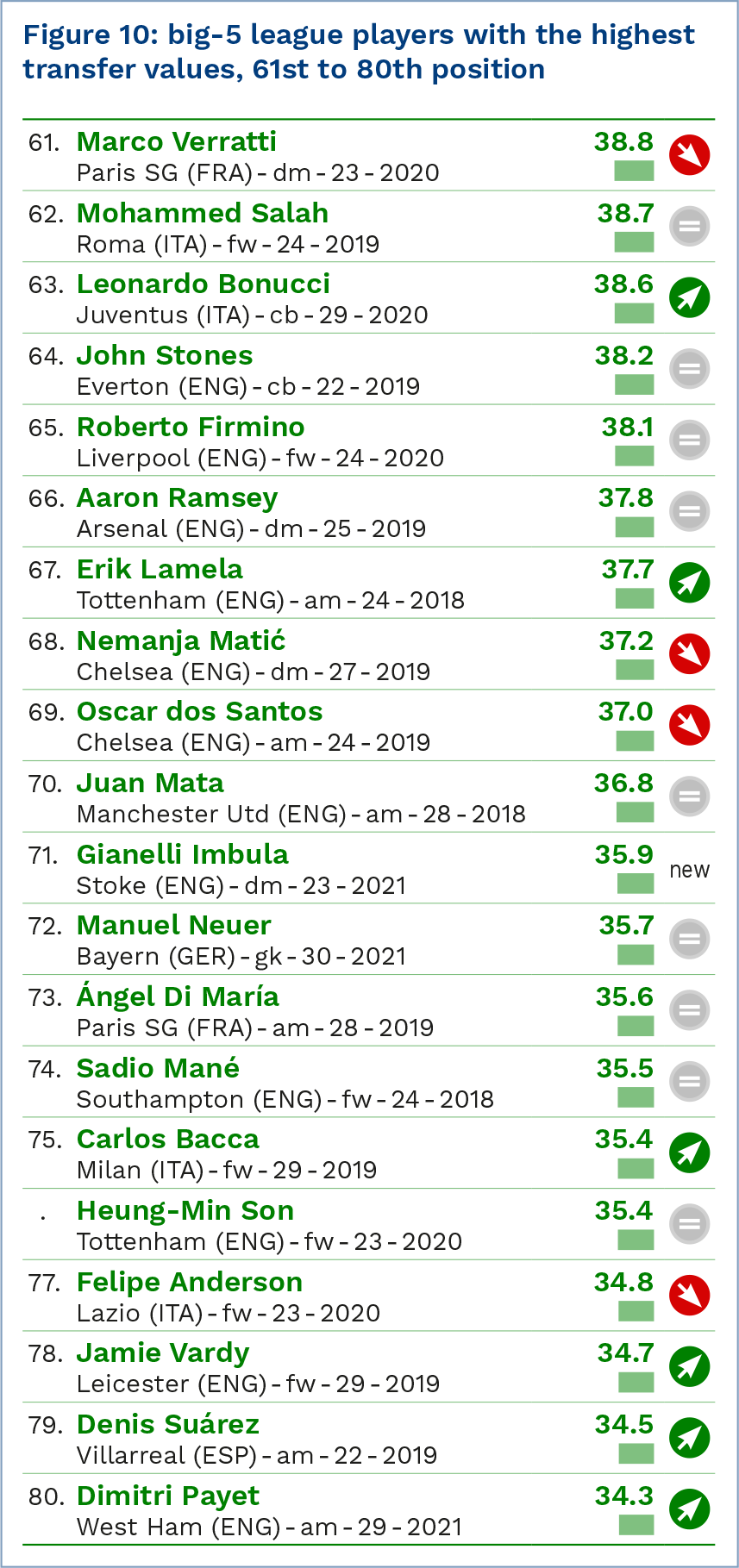
Thanks to the outstanding performances with Dortmund, Henrikh Mkhitaryan is the only player with one year of contract remaining among the 100 most expensive big-5 league players. Two young German talents also have very high transfer values: Leroy Sané (€34 million, 81th) and Jonathan Tah (€29.4 million, 100th). Given their age and ability to progress, their transfer fee could increase even further in a year’s time, unless a top club decides to act quickly as Manchester United did in August 2015 with Anthony Martial.
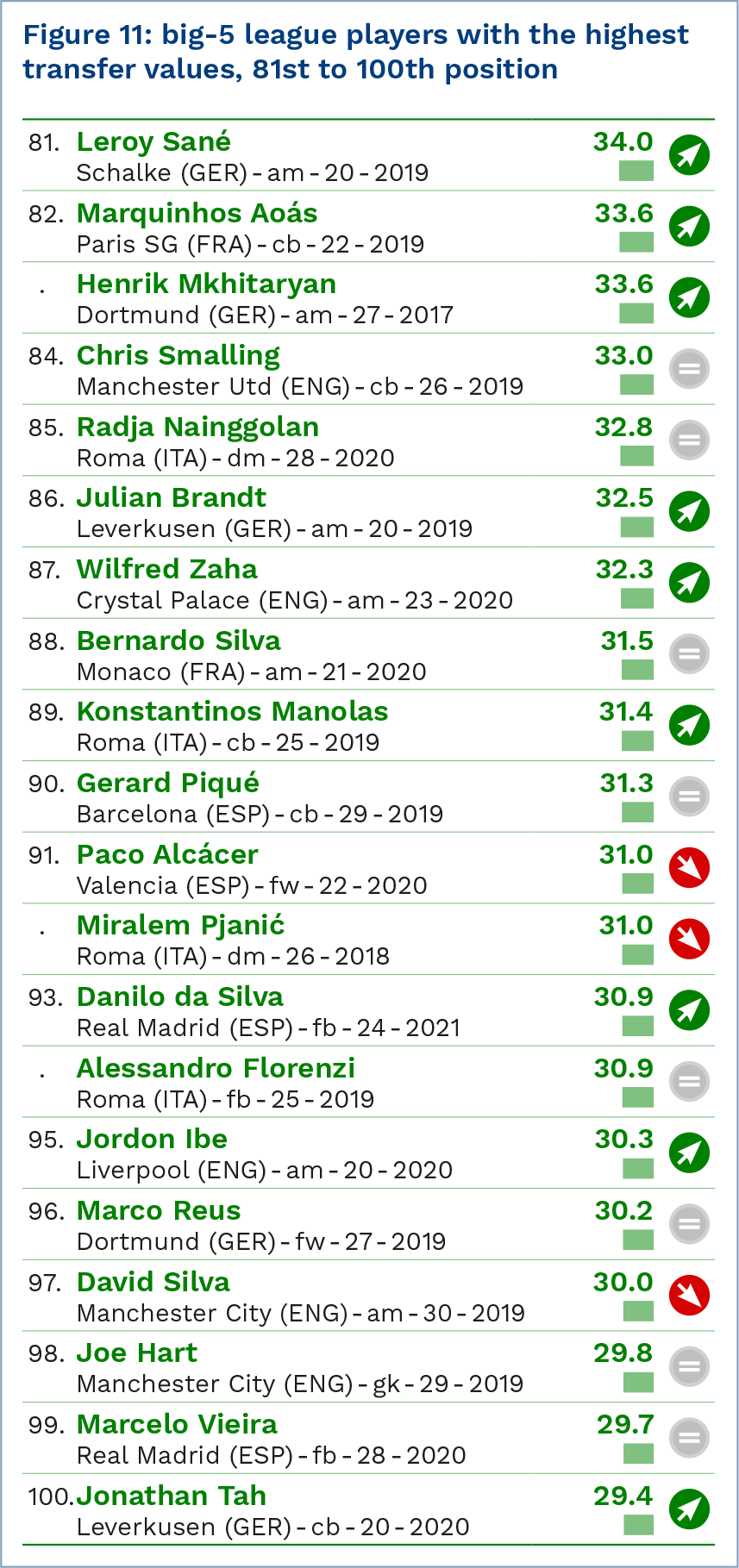
An interesting observation is also the over-representation of English Premier League players among those with the highest transfer values: 7 in the top 20 rankings, 17 in the top 40, 29 in the top 60, 41 in the top 80 and 46 in the top 100.
This result is a reflection of the financial clout of English clubs that allows them to attract numerous talents from abroad each year. Moreover, transfer costs between Premier League teams are generally higher than between clubs from other championships. All things being equal, the value of a Premier League player is thus higher than that of a footballer playing in other competitions.
5. Conclusion
The pioneering approach developed by the CIES Football Observatory in the field of evaluating transfer probabilities and values of professional footballers is suitable for multiple applications that we shall briefly illustrate below.
Firstly, our approach can be of the utmost use in transfer negotiations. The estimated value can indeed serve as a reference for the different parties involved: the buying club, the selling club, as well as the player’s representatives. Moreover, as the initial valuation is often decisive in the determining of the final price, any valid information that one can have access to allow one to have an advantage in the negotiations.
The algorithm developed for transfer values is also useful in case of litigation. The previous clubs of players very often have a percentage on the future transfer (“sell-on fee”). If they deem themselves to have been wronged and wish to contest the amount for which a player was transferred, they must do this using objective elements. Our approach has already proven to be very useful in this domain. We can also assist clubs entitled to a share of the transfer for a player exchanged, even though the exchange has not involved a monetary transaction.
With the increase of transfer costs and the growing importance of revenues generated from transferring players in clubs’ business model, it has become more and more useful to take out an insurance that allow teams at least some partial compensation for the decrease in the transfer value of a squad member through injury notably. In order to do this, a continual evaluation of the transfer value of a player and the elaboration of different scenarios to estimate his future value are essential. Thanks to our methodology and independence, we are in an ideal position to advise the different actors in this area.
Within the same perspective, the objective estimation of the transfer value of players can be of considerable interest in obtaining credits. This value can be used as a guarantee to convince banks or other types of creditors to grant loans. The algorithm estimating the probability of paying fee transfers can also be used to this effect. Measuring the possibilities of players’ transfers is notably useful in estimating the risks undertaken. In this case also, our services are addressed equally to the different parties involved.
The recourse to the statistical models estimating both transfer values and probabilities is also very valuable in the framework of negotiation concerning contract extensions. It notably allows club officials the analysis of different scenarios so as to define the level of salary that can be offered to players without taking an excessive financial risk. It can also be useful to determine the optimum length of a new contract from an economic perspective.
Last but not least, aside from all commercial considerations, we believe that our approach is of great value for the sustainable development of professional football. It brings an added degree of transparency and objectivity in transfer operations. Up until the present, no organisation was indeed in a position to judge on a solid and credible scientific basis whether transactions were sound.
The principle challenge that awaits us is to popularise further our approach to become a more and more widely recognised actor in the milieu of players’ transfer market. With this in mind, we aim to make more and more data available on our site. The latter is addressed not only to the game’s professionals, but also to the keen football passionate that we are part of. Do not hesitate to contact us for more information.
Monthly Report n°16 - June 2016 - Transfer values and probabilities